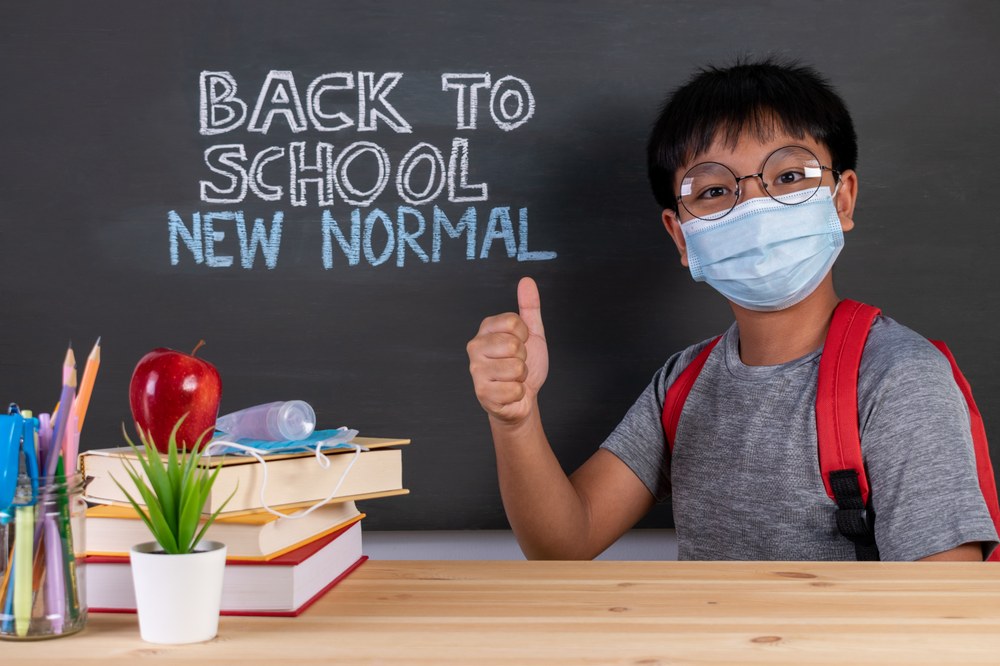School nurses will be at the forefront of COVID-19 mitigation, diagnosis, and control strategies

Back to School: New Normal; Photo credit: Lionday-FreePik
Hannah S. Tiffin
With many schools contemplating full school reopening plans in the near future, risk mitigation and control for COVID-19 is top of mind for many, from public health professionals to school administrators, educators, parents, and students alike. School nurses will be at the forefront of COVID-19 mitigation, diagnosis, and control strategies. As such, a focus on an integrated holistic approach to COVID-19 transmission mitigation is essential. This includes promoting behavioral and cultural tactics for reducing transmission, such as limiting close contact between individuals and emphasizing the need and utility of face-mask adherence. In addition to person-to-person respiratory transmission of COVID-19, there are numerous additional considerations for re-opening school buildings- including safely re-opening buildings that have been closed for extended periods and controlling for bacterial and arthropod pests using safe and effective practices. One Health and integrated pest management tactics will be critical for safely and effectively re-opening schools, by using the One Health perspective of the extensive and interconnected linkages between environmental and human health and the varied tactics employed under the integrated pest management paradigm.
Fortunately, several groups are hard at work developing concrete plans for safe school re-openings. One notable example is the Pittsburgh-based nonprofit Women for a Healthy Environment (WHE). While school cleaning, ventilation, and building health may not have always been at the forefront of public knowledge, WHE have been working hard behind the scenes to survey public schools on their cleaning and pest management practices. According to Kara Rubio, Healthy Schools PA Program Coordinator for WHE, they have been focusing their efforts on the “less conspicuous parts of public schooling - ventilation, windows that work, and cleaning to name a few.” Rubio highlighted results of WHE’s large survey effort of Pennsylvania public schools that showed that many school districts are making a positive switch to keeping fewer cleaning products on hand along with an increase in the use of third-party certified environmentally friendly or “green” cleaning products.
Another key facet to public health is the idea of One Health, the concept that the environment, human, and animal health are all intricately interconnected. Towards this end, Reg Hoyt has been leading a team at Delaware Valley University to start a One Health program at the University-level, and with a seminar series open to the public. The goal of this program is to be “absorbed across the entire campus with the potential to incorporate One Health ideas across all majors.” A lofty goal, but one which only holds more weight during a worldwide pandemic, highlighting the need for interdisciplinary collaboration and greater attention paid towards a healthy environment.
But how does this relate to public schools and the Pennsylvania Association of School Nurses and Practitioners (PASNAP) Annual Conference? COVID-19 is a “pest”, and, just like any other pest in a school setting that needs to be controlled and risks mitigated in a safe manner, the principles and protocols of integrated pest management (IPM) will provide guidance. While sales of disinfectants have increased during the pandemic, these now ubiquitous products are regulated pesticides and require safe usage and storage procedures. As Michelle Niedermeier, School and Community IPM and Environmental Health Program Coordinator for the PA IPM Program, emphasized, “schools have been closed for an extended period, reopening can be risky for a lot of reasons.” In addition to the risk of COVID-19 transmission when students return, there may also be a higher abundance and diversity of pests present than are usually handled during the school year, including the commonly anticipated pests such as cockroaches, but also bacterial “pests” such as Legionnaires. These potential pest challenges require a holistic approach that includes early planning for prevention, control, and mitigation of bacterial, viral, arthropod, and other animal pests, along with plans that limit chemical applications for a healthier environment and healthier school populace.
Applying integrated pest management tactics to limit COVID-19 transmission, along with early planning for the likely increase in non-COVID-19 pests due to extended school closures, public schools can safely reopen and contribute to a One Health paradigm in which environmental health is not sacrificed in the name of human health.
The PA IPM Program is a collaboration between the Pennsylvania State University and the Pennsylvania Department of Agriculture designed to promote integrated pest management in both agricultural and nonagricultural situations. For more information, call (814) 865-2839 or visit https://ento.psu.edu/research/labs/rajotte
Written by: Hannah S. Tiffin, hsg14@psu.edu

